|
COLECOVISION AND ADAM SPECS

ColecoVision :
Resolution: 256 x 192
CPU: Z-80A
Bits: 8
Speed: 3.58 MHz
RAM: 1K
Video RAM: 16K (8x4116)
Video Display Processor: Texas Instruments TMS9928A
Sprites: 32
Colors: 16
Sound: Texas Instruments SN76489AN; 3 tone channels,
1 noise
Cartridge ROM: 8K/16K/24K/32K

Adam :
Resolution: 256 x 192
CPU: Z-80A
Bits: 8
Speed: 3.58 MHz
Video Speed: 10.7 MHz
RAM: 64K (128K optional)
Video RAM: 16K (8x4116)
ROM: 8K
Video Display Processor: Texas Instruments TMS9928A
Sprites: 32
Colors: 16
Sound: Texas Instruments SN76489AN; 3 tone channels,
1 noise
Cartridge ROM: 8K/16K/24K/32K
Disk Drives: 2 * 160K (opt)
Digital Data Drives: 2 * 256K
Modem: 300 Baud (opt)
Printer: 120 wpm Daisy Wheel, 16K buffer
Other: Serial/Parallel Port (opt), Auto Dialer (opt)
 What really distinguished the ColecoVision from other systems of the era was its 32 sprite capability. It made it easier to design sprite intensive games like Slither.
What really distinguished the ColecoVision from other systems of the era was its 32 sprite capability. It made it easier to design sprite intensive games like Slither.
Scrolling on the Coleco was sort of chunky because they did not have special hardware for scrolling like the Atari units did - but some games (notably Jungle Hunt and Defender) _do_ manage to scroll well, so there was a software workaround of some kind.
All Coleco cartridges, and many third party titles, incorporated a patience-testing twelve second delay before the game select screen showed up. One story commonly cited (and apparently mentioned in Electronic Games magazine at the time) is the following: before ColecoVision reached the marketplace, Coleco invested heavily in advertising for the system, building up significant demand. The problem was software support. Few programmers knew the ColecoVision's quirky assembly language, and there wasn't time to train more. So the engineers at Coleco designed an emulator that allowed progammers to code in a far more common and well known language, Pascal.
Coleco then hired programmers familiar with Pascal to design software for the ColecoVision, and thus were able to provide software to meet the demand. The only problem with the scheme was the twelve second delay the emulator caused while starting up.
As good a story as this makes, it's incorrect. The real reason behind the twelve second delay is a loop in the ColecoVision BIOS - the delay was purely intentional. The way companies such as Parker Brothers, Activision, and Micro Fun avoided the delay was to simply bypass the ColecoVision BIOS. - JC, 08, 10, 12, 27, 29
THE HARDWARE LIST
Manufacturers:
AM) Amiga
CB) CBS Electronics
CE) Championship Electronics
CO) Coleco
HS) High Score
PP) Personal Peripherals
PS) Pusher Sales
SU) Suncom
SV) Spectravideo
TG) Telegames
VP) Video Product Sales
WI) Wico
The Hardware
Name
Manuf.
Nbr
Comes with
ColecoVision
CO
Donkey Kong
Perma Power Battery Eliminator/AC Adapter
CO
2298
Dust Cover
CO
Expansion Module #1 (2600 Adapter)
CO
2405
Expansion Module #1 Adapter
CO
Expansion Module #2 (Driving Controller)
CO
2413
Turbo
Expansion Module #3 (ADAM Computer)
CO
Buck Rogers
Roller Controller
CO
2492
Slither
Super Action Controllers
CO
2491
Super Action Baseball
 |
 |
 |
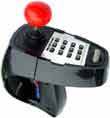 |
Third party accessories
Name
Manuf.
Nbr
Comes with
Champ Adaptor
CECA-340
CBS ColecoVision
CB
Donkey Kong
Co-Sticker
PS
EVE Voice Module
??
Grabber Balls
HS
Injoy-A-Stick
VP
Joy Sensor
SU
Joystick, ColecoVision
WI
Personal Arcade
TG
Meteoric Shower
Power Stick
AM
Quickshot III Deluxe
SV
SV103
Snapper
SU
CLC-006
Super Sketch Pad
PP
G2500
Sketch Master
Unreleased Hardware / Prototypes
Expansion Module #3 (Super Game Module - wafer version) by Coleco.
With 30K RAM and 128K "microwafers" shaped like miniature diskettes. The games were to have intermissions, high-score lists, and extra levels. It was to be packaged with Super Donkey Kong; later, that was changed to Super Buck Rogers and Super Gorf. It could have been an excellent addition to the ColecoVision system allowing you to play your old carts and the new Super Games, but Coleco decided to turn it into the ADAM computer. - JC, 25
Kevin Slywka submits the following:
The following is a quote from the article, One million A.C.(after ColecoVision) Brown, Michael William; Electronic Fun: Computers and Games; June 1983
-Note: The article contains several screen shots and a what appears to be a mock up of the Super Game and several game wafers. "...the Super Games are stored on mini-cassettes (which are about the length and width of a business card) called Super Game Wafers... the module has a magnetic micro-tape drive mechanism behind a slot in the front left panel. Inside the wafers is approximately 50 feet of specially formulated magnetic tape about an eighth of an inch wide." (Brown p41)
Brown claims to have played the system for 8 hours over two different days. Load time for the wafers is clocked at about 10 seconds. Super Games Brown tested: Super Donkey Kong, Super Donkey Kong Jr.,
Super Smurf Rescue in Gargamel's Castle. Brown further notes better colors and additional levels in all three games. Planned titles included: Zaxxon, Buck Rogers Planet of Zoom, Time Pilot, Turbo and Sub-Roc. Brown also notes the ability to enter your initials for high score, which is then stored on the tape.
In Video Games Magazine(Feb.'84) an article on the Texas Instruments Compact Computer 40 (a peripheral for the TI 99/4A) mentions the tape wafers meant for the Super Games: "...this system uses the Entrepo floppy wafer system that is in use elsewhere, and was almost part of Coleco's Super Game Module and ADAM."
The Super Game Module appeared to not have a realistic chance of success at Coleco Industries. In an interview of Coleco president, Arnold Greenberg, by Steve Bloom (Video Games, Oct. '82) Bloom paraphrases Greenberg as saying, "...it is Colecos resolve to market a keyboard (Module #3) some time next year." In Electronic Games (Jan. '83): Test Lab (Cohen, Henry B.) writes that, "...Coleco is working on a keyboard and Ram Cram for ColecoVision which should turn the system into a full- scale, high powered home computer system." Clearly Coleco intended to develop a ADAM-like computer all along, but the question remains as to why they decided to develop the Super system in the first place. If the Super module had been released it likely would have insured Colecos success for at least a while longer. Although given the cynicism of magazine writers and consumers after the Super Module failed to appear it is uncertain if it would have been enough to save Coleco from its eventual fate.
Description of the pictures in the Electronic Fun magazine article(kws):
The module shown appears to be the real thing(although almost certainly a mock-up) with a slot for the super tape wafers on the left side of the module(even a small slot that corresponds to the door on the super wafer can be seen). A small LED is near the super wafer door, probably to indicate a read\write or power light. The "Expansion Module Interface" is on the lower right of the module. The top of the unit has the ColecoVision face-plate and a reset button on the far right.
Below the module three wafers are shown: They have the appearance of micro-cassettes, they are all black and appear to have a door on the left rear of the wafer. Super Donkey Kong, Super Donkey Kong Junior, and Super Smurf (in fine print: Rescue in Gargamel's Castle) are represented. There is a game package which bears a striking resemblance to a CD jewel case (although it appears to be made of vinyl) has Buck Rogers Planet of Doom on the cover. The by-line on the case states:
"For use with ColecoVision Expansion Module #3"
"AN ADVANCED VIDEO GAME THAT"
"PLAYS ALL SCREENS INCLUDING"
"BEST SCORES AND INITIALS!"The vinyl game case carries a part number of "#2645" - 25
Expansion Module #3 (Super Game Module - CED version) by Coleco.
A second Super Game module was also rumored. It used a format called CED, using video records - vinyl records with much finer grooves, stored in cases so as to avoid contact save by the needle of the system. In an interview with Ralph Baer, who worked on this system, he said it was really zippy and in some respects better than CDROM. - 11, 34
CED stands for Capacitance Electronic Disk system, and was pioneered by RCA. RCA used this technology in all of their CED video disk players, which competed with the Laserdisc format until 1985 when RCA discontinued all of its players. Coleco chose the CED format because RCA could create a computer controllable random access machine that was very affordable. The Coleco CED system would have come with two major components: the Coleco "controller" Module (#3) that plugs into the front of the system, and the RCA/COLECO CED player that connected to the Module and the T.V. set. Reportedly the price would be around $395-$495 for a complete set-up. Interestingly, the Coleco CED system would still play all of RCA's movie and music video disks, which was a big selling point for RCA. So you would have a Video Quality arcade system, and movie player - all in one.
From Video Games and Computer Entertainment, June 1991: 'Talk of the future reminds Baer of the aborted, ahead-of-its-time project he launched in 1982. The ideal interface, the ColecoVision video game console and an RCA CED player. "Things advanced to the point that RCA actually made a few CED peripherals. Then along came the ADAM computer and ended it all. What I'd like to see is not going to happen." He'd like to see CED revived, instead of the industry going to CD. He worries that CD will fail to deliver the full-motion video that people expect.' - 12
ColecoVision (THE ORIGINAL VERSION) by Coleco.
Remember seeing the first "glimpses" of the ColecoVision system in Electronic Games magazine? The first pictures of the system showed a much more attractive looking system than what we got as a final product. The system itself had a white faceplate where the ColecoVision logo appears now and the controllers were very different. They had blue side buttons, orange pound and star keys on the keypad, and the finger rollers that were later introduced on the Super Controllers.
The finger rollers, which were to have been located between the keypad and joystick, were supposed to be available for use as either speed controllers, or as a paddle controller. They were dropped at the last minute, though if you open up a controller you can see the schematic for it on the circuit board. - 07
The finger rollers shown in Daniel Cohen's book "Video Games", page 57, are located beneath the keypad. - 24
Intellivision Adapter by Coleco.
Coleco had plans for an adapter that would play Intellivision cartridges. Supposedly there are several working prototypes of this adapter that were shown at electronic shows. If Coleco would have only gone through with production, the ColecoVision would have been able to play Intellivision, 2600, and ColecoVision cartridges! - JC
Modem by AT&T/Coleco.
Not to be confused with the ADAM modem, which does exist.
An article in Newsweek, September 19, 1983, on page 69 announced the following: 'American Telephone and Telegraph Co. and Donkey Kong? An unlikely combination, perhaps, but one that became a reality last week when the venerable communications giant hooked up with Coleco Industries, the videogame maker, in a join effort to make entertainment software available by telephone to 25 million owners of video games and home computers.' 'Under the plan, AT&T and Coleco will develop a "modem", an electronic device that will connect a home computer or video game by telephone to a central data base. Coleco will supply the software programs, such as Donkey Kong or two of its other popular video games, Smurf and Zaxxon. The service will be offered sometime next year for about $20 a month; the modem is expected to cost $100.' - 13
Sensory Grip Controller by Coleco.
The Super Action Controllers were supposed to have a sensory feature, so that when (for example) Rocky threw a punch in Super Action Boxing, you would feel it in the handle. - 13
THE COLECO ADAM COMPUTER

 The Coleco Adam was designed and built in the early 80s as a compliment to the Colecovision video game system. The Adam computer uses a similar internal architecture but adds four slots (that are reported to be nearly Apple ][ compatible) as well as a peripheral “network” to which everything in the system is attached. The disk drives, keyboard, controllers and printer all communicate with the CPU via this network. Interestingly, the Adam printer (a slow and noisy daisy wheel) is the power source for the entire system.
The Coleco Adam was designed and built in the early 80s as a compliment to the Colecovision video game system. The Adam computer uses a similar internal architecture but adds four slots (that are reported to be nearly Apple ][ compatible) as well as a peripheral “network” to which everything in the system is attached. The disk drives, keyboard, controllers and printer all communicate with the CPU via this network. Interestingly, the Adam printer (a slow and noisy daisy wheel) is the power source for the entire system.
The Adam computer has a built-in word processor that is the default program run when the machine is powered on. Other software can be run from either the cartridge slot or the two high-speed tape drives built in to the front of the unit. Being a Z-80 based machine with reasonable memory (64K) the Adam was even capable of running CP/M.
The Coleco ADAM came in two forms. You could buy the complete system, or, if you already owned a ColecoVision game system, you could buy an add-on for it.

TELEGAMES PERSONAL ARCADE/DINA2-IN-1
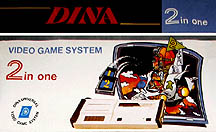

INTRODUCTION:
TELEGAMES produced and sold a ColecoVision compatible system called the "Personal Arcade". The Personal Arcade was originally produced several years after Coleco stopped production of the ColecoVision.
It's very small (12"x5"x1"), white, and comes with Nintendo-like gamepads. It uses a normal sized power supply (6' cord) which is less than 1/2 the size of the ColecoVision's ridiculously bulky one. It also comes with a game/TV switchbox (10' cord) like the ColecoVision. It also contains two separate expansion ports that were never taken advantage of.
COMPATIBILITY:
The ads and box say "Compatible with over 100 ColecoVision cartridges". TELEGAMES operators claim that it is compatible with 95% of all the ColecoVision cartridges, but won't provide a list of which ones it won't work with. So far I've come up with 10 after testing it on 65 cartridges. Actually, *all* the cartridges work, it's just that the "Personal Arcade" uses different joystick wiring and any cartridge made specifically for the Super Action Controllers, Driving Module, or the Roller Controller will be unplayable, among others. In fact, regular ColecoVision or Atari compatible joysticks cannot be used on the Personal Arcade either.
GAMEPADS:
The gamepads are 1 3/4" x 4 3/4" and nicely fit into the sides of the unit. The cables are 3 feet long and stiffer than normal. A personal grudge is the fact that the cables attach to the side of the gamepad instead of the rear, making it harder to comfortably grasp. They are also slightly too small and cheaply made in my opinion.
KEYPAD:
A single keypad is built into the unit and the buttons are a smaller 3/8" square, compared to the 5/8" square of the normal ColecoVision controller. It is made of a thin membrane that works with the slightest touch. The keypad has no frame like on the ColecoVision controller. It looks like the following:
1 2 3 4 5 *
6 7 8 9 0 #This changed keypad size and format means overlays cannot be used. It also means it is very difficult to play keypad intensive games where quick reflexes are needed. Now you must take your hand off the gamepad, and look down to press the right key, instead of the ColecoVision joystick where you just move your thumb without looking.
NON-COMPATIBLE LIST:
The following are unplayable on the Personal Arcade due to controller problems:
Fortune Builder (needs 2 separate keypads in 2-player head-to-head mode) Front Line (Super Action Controller game) Rocky Super Action Boxing (Super Action Controller game) Slither (Roller Controller game) Super Action Baseball (Super Action Controller game) Super Action Football (Super Action Controller game) Super Action Soccer (Super Action Controller game) Super Cobra (2nd button "bomb" doesn't work) Turbo (Driving Module Game) Victory (Roller Controller game)
KEYPAD INTENSIVE LIST:
The following do work perfectly on the Personal Arcade, but are difficult to play because of the need for very quick keypad presses:
Aquattack, Blockade Runner, Mouse Trap, Spy Hunter, War Games
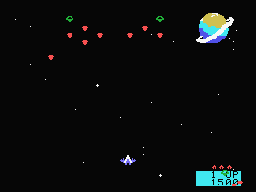 BUILT IN GAME:
BUILT IN GAME:
The Personal Arcade comes with a built-in game called "Meteoric Shower". A decent shoot'em up game in which you have a ship in the middle of the screen and you shoot waves of enemy ships that attack from above and below.
DISPLAY:
The Personal Arcade removes the famous multi-colored "ColecoVision" opening screen from all of Coleco's cartridges, replacing it with a green background and Japanese writing, with the words "1986 BIT CORPORATION". Other publisher's opening screens are unaffected.
Based upon a review by James Carter
NOTE: Telegames lost all of their Personal Arcade stock to a tornado in April, 1994.
OTHER COLECOVISION CLONES
Bit Corporation - the ILO 90

Developed in 1984, this computer was apparently never distributed via an official circuits in the west. Very largely inspired of the design and the hardware of Sega SC-3000. It is rumoured to be compatible with this system as well.
Hanimex Pencil II

The Hanimex company, known for its pong clones, developed this obscure machine in 1984. The machine can, thanks to an extension, use the Colecovision cartridges.
Splicevision
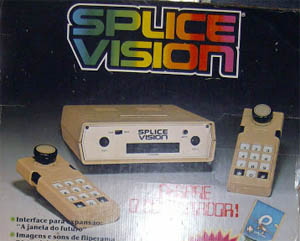
This is a Brazilian clone manufactured by a Brazillian telephone compant (Splice). It is rumoured that an 2600 adapter was also developed for this system.
ColecoVision Extension for the Spectravideo SVI-603
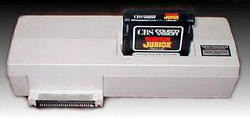
This is not a stand-alone system, but an extension intended for Spectravision 318 and 328 consoles.
HARDWARE TIDBITS
Atari Touch Pad / Children's Controller / Star Raiders Controller
The following buttons and/or combinations of buttons correspond to various inputs on the ColecoVision:
DESIRED PRESS THIS ON
COLECO KEY ATARI TOUCH PAD
-----------------------------------------------
1 * position
2 7 position
3 1 + * + 7. The 7 may not be necessary.
4 1 + 4 + 7 + *.
5 4 + 7.
6 1
7
8
9
* 4 + *
0 1 + 4
# 1 + 7
Left button
Right button 1 + 3, or 4 + 6, or 7 + 9, or * + #. - 20
CBS ColecoVision
Looks and operates just like my 'standard' ColecoVisions, but the metallic faceplates are different. On top, it says "1 / 0" instead of "Off / On", and the front plate reads:
CBS Coleco Video Game/Home Computer System [expansion slot] CBS Vision Electronics

CBS Electronics bought out the Coleco rights when Coleco bit the bullet. They marketed mostly in Europe. You can find most if not all of the Coleco games with a CBS label. They are all or mostly all PAL games. However, since the ColecoVision doesn't care, it doesn't matter. Plug them in and they play like NTSC! - 20, 22
CBS ColecoVision - France
The front plate for the French ColecoVision reads:
CBS Coleco Ordinateur Multi-Services [expansion slot] CBS Vision Electronics

In France, the Coleco system was introduced as a Micro-Computer, and remained in stores until 1985. The ADAM was very lightly marketed in France. - 61
 Champ Adapter
Champ Adapter
A near exact duplicate of the Coleco Keypad, minus the upper half that contains the joystick. Instead it has a 9-pin slot so you can plug in your favorite joystick and still have use of the keypad.It also can double as a joystick extension cable since the Champ Adapter cable is 6' long. - JC
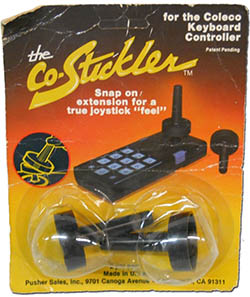
Co-Stickler
Plastic "snap" on joysticks for the standard ColecoVision controllers. - JH
EVE Voice Module
A seperate white box which plugged in to the expansion port on the ADAM. - 60
 Expansion Module #1
Expansion Module #1
The following Atari 2600 cartridges are incompatible with the 2600 Adapter:
Texas Chainsaw Massacre - JH Most Tigervision titles - 19 (but Miner 2049'er works - JH) All Supercharger games - 19 (will work, but only if cover of expansion module has been removed) - 26
 Expansion Module #1 Adapter
Expansion Module #1 Adapter
This device plugs into Expansion Module #1 (2600 Adapter) to allow some Atari 2600 cartridges which have compatibilityproblems to be played. Supposedly it was only sent through the mail to those customers who called Coleco with complaints of 2600 cartridgeproblems. - JC

Expansion Module #2
The driving controller can be used to play Victory,which officially requires the Roller Controller. - 46
Grabber Balls
They're red balls of a stick that snap on the ColecoVision controller, making it more arcade-style. Work *fantastic* when locked into the Roller Controller, and played with Robotron on the 7800. -JC

Injoy-A-Stick
Replacements for the standard ColecoVision knob joysticks, which are considerably longer. - 63
 Joy Sensor
Joy Sensor
A lot like an Intellivision II controler. Has a membrane kepad area and a membrane joystick, plus what appear to be rapid fire controls that might be variable. Well made. - 41
Perma Power Battery Eliminator/AC Adapter
Replaces the batteries in Expansion Module #2 (Driving Controller) - JC
This is a _weird_ device. Since the only way to power the unit is with batteries (there's no alternate for a power source, so the connection is required), the "Battery Eliminator" is shaped like batteries. - JH
 Power Stick
Power Stick
A great joystick for non-keypad, one button games. Having the keypad and second button above the joystick makes it awkward for those games, though. - JH
Roller Controller
To use the Roller Controller on a game which doesn't require its use (such as Centipede or Omega Rage), leave the Joystick/Roller switch in the Joystick position. - JH
Driving Module games can be played with the Roller Controller by doing the following:
1) Switch the setting to "Joystick".
2) Choose the game you wish to play.
3) Switch the setting to "Roller Controller".
4) Go. The leftmost button acts as the accelerator.Direction can be changed using the joystick in someas-yet undetermined manner. - 24
You can get very strange behavior by using the roller controller for joystick games? Try wiggling it around while playing Smurf and you can move above or under the proper "ground" area so that none of the enemies can kill you! - 14

Snapper
Joystick height extenders which snap onto the joysticks. Of limited usefullness, as they come off easily. - 63
Super Action Controller
To play games that require the Driving Module with the Super Action Controllers Roller acts as steering wheel except when you roll it left the car turns right and vice versa. Up on the joystick is to shift gears to make the car go faster. Gas pedal is either automatically pressed down or try the buttons on the controller. - TC
Super Sketch Pad
Came in a box with a black background and a horizontal rainbow across the top, marked "Super Sketch". In addition to the ColecoVision version, there were Commodore 64, Atari 8-bit, & TI 99/4A models. The ColecoVision version has a silver sticker on the top right corner that says Model G2500 For Use with Colecovision. The Sketch Unit itself is white with a brown plastic piece used for the drawing. One of the strangest things about it is that it does not plug into the joystick port. The cable is attached directly to the right side of the cartridge. The cartridge label is mostly silver with Super Sketch with the horizontalrainbow with it.
The sketch unit it has 5 controls. Two "Lift" buttons, one on each side, allow drawing to be turned off. "Select" allows selection of colors and menu items on the left side of the screen; "Menu" brings the menu up and/or removes it.
The program itself say Super Sketch while fluctuating through different colors upon power-up. Just below that it says:
Copyright 1984 Personal Peripherals, Inc.
Irving,Texas
By: Steve Roubik
Press MENU to proceed. The program really is nothing more than a doodle program. Menu options are:
Clear
Swap
Expert
Brush
(The 16 Colors)
Eraser
Draw
Fill
ShowIt comes with a large white envelope that says Super Sketch starter kit. Inside is the owners manual, quick reference card, 6 drawings to trace with, and a warranty card. - 42
Telegames Personal Arcade
The Personal Arcades were originally made by the Bit Corporation, and marked as DINA units with a second cartridge slot for some unknown purpose. - 30
The joypads that come with the Personal Arcade are 2600 compatible; they also have an irksome quirk for anyone used to the ColecoVision: they're reversed (i.e. right is left, left is right).
Besides the games listed above, Smurf Rescue in Gargamel's Castle is incompatible with some Personal Arcades, and the 2600 Adapter will not work due to power and RF cable positioning.
The pause switch is incompatible with ColecoVision cartridges, so it is apparently used by cartridges which go in the second slot. - 14, 52
At least two different version of the Personal Arcade (with different power supplies) exist. - JH





